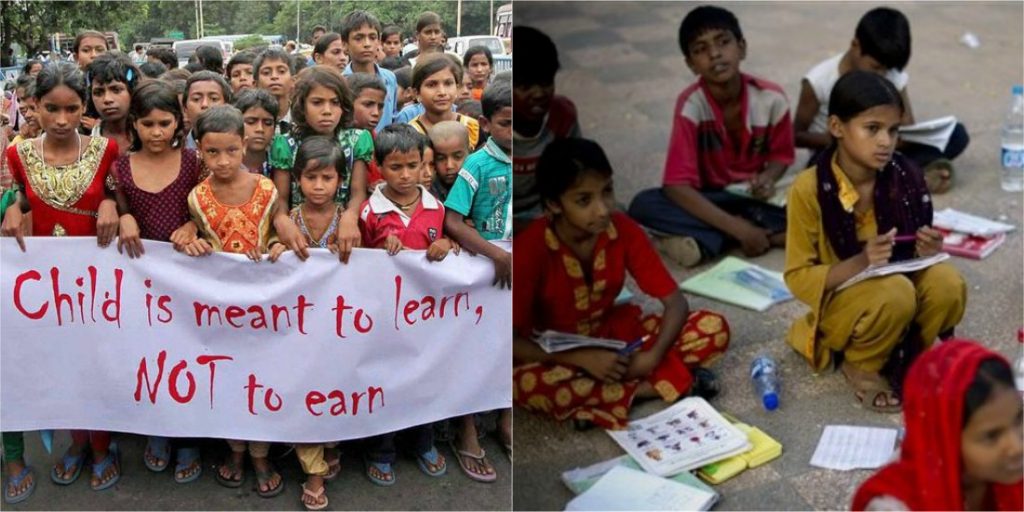Disclaimer*: The articles shared under 'Your Voice' section are sent to us by contributors and we neither confirm nor deny the authenticity of any facts stated below. Parhlo News will not be liable for any false, inaccurate, inappropriate or incomplete information presented on the website. Read our disclaimer.
This post is also available in: العربية (Arabic) اردو (Urdu)
Barefoot in a skimpy brown vest, eleven-year-old Haris, has a full day. He gets up in the morning, helps his mother with household chores then goes to a lower-middle-class private school in his area. In afternoon after school, he had to leave urgently for his job in a tailor’s shop where he works till night, as he goes home he looks after his 3 younger siblings and eats what he gets as his dinner.
Haris found time to attend school for a brief period of 6 months but he had to leave when the burden on his shoulders augmented he looked after his mother and his other younger siblings along with his duties in the tailor’s shop. Haris is like many other Pakistani children who are the victim of an existing oppressive system.
Pakistan is among the few South Asian countries where the labor of children is intensely exploited. The heavy demand for work is the primary reason why the poor children drop out of school or stay away and why Pakistan’s primary enrollment rate and the literacy rate is the lowest in the South Asian region. After the breakdown of colonialism in subcontinent and independence of Pakistan the enrollment rate in primary and secondary level rose, which represents enormous efforts to mobilize the trends of modern and basic education for all in the region.

Apparently, the trends changed and education became more common as it was rare in old times but still we see that our education system is failing in its potential role as a prime agent of national development. Budgets brought more constraints and the debt problems the growth in public sector education leveled out dropout rates of children from public sector schools rose rapidly. Challenges for poor increased, schools are failing to provide equal opportunities for underprivileged and rural children. Education in public sector is sparse while private education cost deterred the poor.
More than 50% of the population of Pakistan is educationally handicapped because the variety of socio-economic factors had prevented the brains of the people from developing fully. Even for many of those who managed to preserve their seats at schools are often condemn to other factors as there are not enough jobs commensurate with their needs in times of poverty and inflation. Our traditional education system did not become a mechanism for ensuring high rewards for the few and carried failure with continued poverty for the many, nor did it help us to develop.

The academic curriculum is taken over from former colonial powers without modification that is often irrelevant and alienated with a foreign language. It lacks the skills required for development or at least for survival. It deprives local children of their own culture and built dreams of urban westernized values and ambitions leaving their rural areas in isolation and ignorance.
There is a group of poor people who often send their children to low-cost public sector school for the sake of good quality education but unfortunately, the curriculum gives them no incentive to learn. The system of those schools is over ambitiously designed to eliminate all the pitfalls of the students who fail to fulfill academic requirements, but if children answer questions wrongly or didn’t turn up to school in proper uniform or on proper time they often end up leaving harsh remarks with students.

In order to reverse this bias in schooling system of our country we need reforms in education and a framework to improve lives of these poor children of our country; we need a practical curriculum. If education reform is to benefit the communities at the larger scale, it must be introduced nationwide which can only be done by the government, not the NGOs. The practical and unbiased educational curriculum and academic structure relevant to our development needs would help us in equalizing the quality of educating all across the country.
By getting rid of the traditional academic curriculum which had been dominated by foreign imported text and culture would help us in constructing our own innovative ideas of knowledge and learning. It would encourage adaptability and self-sufficiency among our people. Education reform is a colossal venture, in which books have to be rewritten and illustrated, teachers have to be retrained and these reforms would eventually lead us towards the implementation of a fairer and practical development approach.


